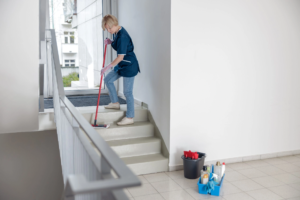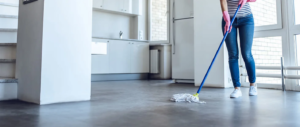[fsn_row][fsn_column width=”12″][fsn_text]
Cleaning your home’s siding is essential to maintaining its curb appeal and protecting it from damage. But, have you noticed green streaks or patches on your siding? If so, you’re likely dealing with algae growth. Algae thrive in damp, shaded areas and can be especially frustrating for homeowners in Richmond, where our humid climate can encourage its growth. So, how to clean algae off house siding? While many websites will recommend basic cleaning methods, we’re going to dive into the details—covering everything you need to know, from why algae grows to cleaning tips that aren’t commonly discussed.
Why Does Algae Grow on House Siding?
Algae is a plant-like organism that grows in moist environments. Here in Richmond, the humidity and frequent rainfall provide the perfect breeding ground for algae. Algae commonly appear on the north-facing sides of homes, where sunlight is limited, leaving the area cooler and damp. Homes located near bodies of water, under large trees, or in areas with high humidity may also be more prone to algae growth.
A study by the Journal of Environmental Science and Technology found that algae growth on siding can occur with relative humidity levels as low as 65%, which is common in Richmond during most months of the year. Algae might not damage your home structurally, but it can ruin its appearance and decrease its value. Furthermore, if left unchecked, algae can lead to mold growth, which can damage the siding material and cause health problems for residents.
The Hidden Truth: Algae is Not Just an Aesthetic Problem
Most websites will focus on how algae makes your siding look unsightly, but there’s more to it. Did you know that algae can retain moisture against your siding? This trapped moisture can lead to more serious issues over time. For example, if you have wood or composite siding, constant exposure to moisture can cause it to warp, rot, or weaken, costing you more in long-term repairs than just cleaning.
Vinyl siding, though more resistant to damage, isn’t immune. Algae and mold can find their way into small cracks or crevices, creating a breeding ground for more severe growths over time. When algae is paired with dirt, dust, and other organic matter, it can create a thick layer of grime that deteriorates the integrity of your siding’s surface.
Traditional Methods to Clean Algae Off Siding
The most common method people use to clean algae is a simple mixture of water and bleach. But while bleach is effective, it can be harmful to your plants, pets, and the environment if not used carefully. A safer alternative is a vinegar solution: mixing three parts of water with one part of white vinegar and applying it to the algae-affected area. Vinegar is a natural cleaner that won’t kill your landscaping and is biodegradable, but it may take a little more scrubbing than bleach.
Another common method is pressure washing, which involves spraying water at a high velocity to remove algae from the surface. While effective, pressure washing can be risky. Too much pressure can strip off paint, dent vinyl siding, or even crack weaker materials like wood. If you’re not careful, pressure washing can cause more harm than good.
What Most People Overlook: The Importance of Pre-Treatment
One of the most overlooked tips for preventing algae growth is pre-treatment. Before algae even appears, applying a protective solution can significantly reduce the chances of future growth. Using a specialized exterior cleaning product or an algae-resistant coating can prevent spores from taking root on your siding.
Many homeowners in Richmond don’t realize that algae grows from microscopic spores carried in the air. Applying an algae-resistant coating creates a barrier that makes it harder for those spores to adhere to the surface. This is especially useful if your home has had recurring algae problems in the past.
Step-by-Step Process: How to Safely Clean Algae Off Your Siding
- Inspect the Area: Before starting, check your siding for damage or loose panels. Cleaning siding that’s already damaged could make the problem worse.
- Choose Your Cleaning Solution: Depending on your siding material, choose a cleaner that’s both effective and safe. For environmentally friendly options, a solution of vinegar and water or oxygenated bleach is recommended. Avoid using chlorine bleach on wood siding, as it can cause discoloration.
- Use a Soft Brush: Using a soft-bristle brush, gently scrub the algae-covered areas. Scrubbing too hard, especially on vinyl or wood, can damage the siding’s finish.
- Rinse with Low-Pressure Water: While pressure washing is often recommended, use a lower-pressure setting or a garden hose to rinse away the solution. High pressure can cause damage, especially to older or weakened siding.
- Apply a Preventative Treatment: Once your siding is clean, apply an algae-resistant solution to protect your home from future growth.
ProClean: Richmond’s Trusted Partner in Algae Removal
At ProClean, we understand the specific challenges that Richmond homeowners face when it comes to keeping their exteriors clean. Our professional exterior house cleaners specialize in removing algae from all types of siding, using eco-friendly methods that won’t harm your plants, pets, or your home’s materials. Our team is trained to assess your siding and recommend the best cleaning methods to ensure a long-lasting clean. With our “exterior house cleaners near me” services, we’ve helped countless Richmond residents restore their home’s beauty while preventing algae from coming back.
The Eco-Friendly Approach: Why Go Green?
Many homeowners opt for harsh chemicals without realizing the impact on their local environment. Richmond’s proximity to the James River and local wildlife means we need to be cautious about the products we use. Chemical runoff from cleaners can make its way into the water system, potentially harming the environment. That’s why at ProClean, we focus on using eco-friendly products that are safe for your home, your family, and the environment. These cleaners are not only effective but also biodegradable, so you can rest easy knowing you’re doing your part to protect Richmond’s natural beauty.
Visit our blog page today and read about “How to Clean Cluttered House?” to learn more!
Conclusion: Keep Your Home Clean and Protected
Algae may seem like a minor annoyance, but it can quickly escalate into bigger problems if left untreated. By understanding why algae grows, using safe cleaning methods, and taking steps to prevent future growth, you can keep your siding looking great for years to come.
At ProClean, we offer comprehensive exterior house cleaning services tailored to the unique needs of Richmond residents. From algae removal to preventative treatments, our team ensures your home remains free of grime and algae. Our experts know how to clean algae off house siding without causing damage, and we take pride in delivering top-notch service with a focus on eco-friendly solutions.
Is your home’s siding starting to show signs of algae growth? Don’t wait for the problem to get worse! Contact ProClean today for a free consultation and learn how our exterior house cleaning services can restore your home’s curb appeal. Our professional team is ready to help you tackle algae growth with safe, effective, and eco-friendly methods. Call us today to schedule your algae removal and protect your siding from further damage. With ProClean, Richmond residents can enjoy beautiful, algae-free homes all year round. Reach out to us now, and let’s get started!
[/fsn_text][/fsn_column][/fsn_row]





